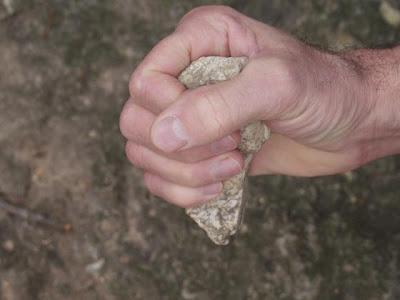 Leakey discovered evidence of man the tool maker over a million years old. What sets man apart from the other tool using animals, like crows and monkeys, isn't the use of tools, but the making of them. A number of animals of different species use sticks to probe nests for bugs and honey. And while man has been making tools for over a million years, it is only in the last 35,000 that man has been using sticks to make handles to increase tool force and accuracy and extend tool range. Two hundred years ago man began his even greater application of force to his tools through the use of steam and internal combustion, and in the last 50 years, tools have been directed toward the elimination of necessary skill and attention from human processes. And so, you could say that the history of tool making really got interesting when we learned to make handles for them. And the making of handles signaled an explosion of human intellect, just as the child's movement in grip from the head of the hammer to the end of the shaft, signals a concurrent expansion of intellect.
Leakey discovered evidence of man the tool maker over a million years old. What sets man apart from the other tool using animals, like crows and monkeys, isn't the use of tools, but the making of them. A number of animals of different species use sticks to probe nests for bugs and honey. And while man has been making tools for over a million years, it is only in the last 35,000 that man has been using sticks to make handles to increase tool force and accuracy and extend tool range. Two hundred years ago man began his even greater application of force to his tools through the use of steam and internal combustion, and in the last 50 years, tools have been directed toward the elimination of necessary skill and attention from human processes. And so, you could say that the history of tool making really got interesting when we learned to make handles for them. And the making of handles signaled an explosion of human intellect, just as the child's movement in grip from the head of the hammer to the end of the shaft, signals a concurrent expansion of intellect.John Grossbohlin sent the following in reference to Mike Rose's essay which I referred to in an earlier post:
"What I saw in Rose's words, more specifically "The best education for work is one that is broader than job preparation, that emphasizes literacy, quantitative reasoning, problem solving, creativity..." is reminiscent of the apprenticeship relationships of 18th century colonial America. The masters we obligated to not only teach the arts and mysteries of the trade but to also teach math, writing, and business skills. This was also the experience my father had as an apprentice tool and die maker in the late '50s.And so, you can see the relationship between tool making, and problem solving as a foundation for such abstractions as managing one of the world's largest and most successful business coporations.
"In a visit to the Kingston IBM plant Tom Watson Jr told the assembled tool and die makers that they were the future of the company... The young guys didn't understand that, they felt they were tool and die makers only. A mid-level manager put it all in context by saying that "you don't think IBM spent all the money on you [to train you] so you would just be tool and die makers do you?" Over time all those highly trained workers went on to be the innovative problem solvers and decision makers that grew IBM in the 70s and 80s... by then IBM started buying their talent on the open market instead of growing their own."
I am going to be on the subject of tools for a time. Get a grip. Put a handle on that thing. The images above and below are of a stone tool, found in my garden and shaped by some long deceased craftsman to fit my hand. It would have been used for softening hides, cracking nuts, or perhaps making acorn flour, with the human arm's own leverage. Our landscaper found them for both left and right. They were quickly shaped and discarded when their work was done.


Still on the same subject, tomorrow the 1st, 2nd, and 3rd grade students will continue making hobbit puppets, and it is interesting to observe which students want theirs to have the stick at the back to control it for performance. The first graders, still getting used to having a handle on things are reticent. They want to hold it more tightly in their own hands... Just as they want to hold a hammer close to the head. Handles being one of mankind's near recent inventions, take a while to enter the developmental landscape.
No comments:
Post a Comment